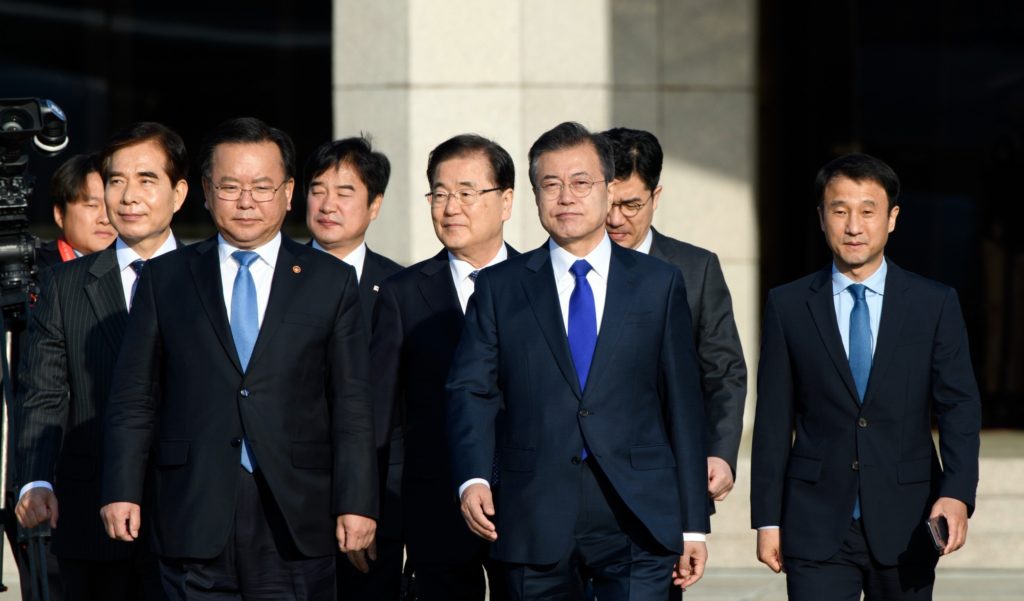The Peninsula
Moon, a Naïve Dreamer or an Ambitious Facilitator?: The Evolution of Debates on the Pyongyang Declaration in South Korea

By Yonho Kim
While the American media was assiduously covering the controversies over sexual misconduct allegations against Supreme Court nominee Brett Kavanaugh, the leaders of two Koreas signed a historic agreement in Pyongyang on September 19. At the end of their third summit, South Korean President Moon Jae-in and North Korean leader Kim Jong-un announced the Pyongyang Declaration with further concrete measures on tension reduction, inter-Korean cooperation, and denuclearization, envisioned in the April 27 Panmunjom Declaration. Since the Pyongyang Declaration was reported, there have been very active debates in South Korea that evolved as more information on the communications among Washington, Seoul, and Pyongyang was disclosed.
One of the noticeable commitment made by Kim in the Pyongyang Declaration was his visit to South Korea ‘at an early date’ at the invitation of President Moon. Moon explained that it meant ‘by the end of this year.’ Even the conservative Chosun Ilbo appreciated the significance of Kim’s promised visit by pointing out that “it is no small matter if the leaders meet regularly to try and resolve 70 years’ worth of differences.” Chosun Ilbo also noted that for the first time as a North Korean leader Kim made public comments of denuclearization when he said “we have agreed to make the Korean Peninsula a land of peace that is free from nuclear weapons and nuclear threat” at a joint news conference with Moon.
However, the conservatives gave little credit to the Pyongyang Declaration on denuclearization. Byong-joon Kim, interim leader of the main opposition and conservative Liberty Korea Party, criticized the Declaration for making little progress on denuclearization while seriously undermining South Korea’s reconnaissance capabilities. The conservatives’ major concerns are that a commitment to concrete steps toward denuclearization was absent. Kim’s offer to destroy the Tongchang-ri missile engine test facility and launch pad was already made at the Singapore summit with President Donald Trump in June. And the North’s mobile missile launchers, which Kim failed to mention, are more threatening to its neighbors than the Tongchang-ri site. Dismantling the Yongbyon nuclear facility is a long overdue promise. Even after the dismantlement the North will still be able to build nuclear bombs at covert uranium enrichment facilities. To have the denuclearization process move forward, the conservatives argue, North Korea should start with declaring its nuclear warheads, fissile materials and covert uranium enrichment facilities as the U.S. demands.
The Moon government characterizes the Pyongyang Declaration as a de facto end-of-war declaration or nonaggression agreement between the two Koreas. Thanks to the Declaration, the liberal government emphasized, Koreans are finally allowed to escape the horrible threats of war. Furthermore, a prominent liberal expert pointed out that the Declaration involves initial steps potentially linked to an end-of-war declaration between the U.S. and North Korea. He argued that by agreeing to remove the risk of war on the Korean Peninsula, Kim sent a message that the threat to the U.S. Forces in Korea and their families will be removed. Kim’s offer to dismantle the Tongchang-ri missile site in a verifiable way suggests a direct threat to the mainland U.S. will be eliminated. If the end of the Korean War is declared by the end of this year with Trump’s blessing, as the argument goes, Kim will be able to move to the next steps of denuclearization, starting with dismantling the Yongbyon nuclear facility.
The conservatives seemed to be sticking to the idea of ‘frontloaded’ North Korean nuclear concessions when the Trump administration had already started embracing Kim’s ‘corresponding measures’ proposal as a confidence-building step to ensure the Yongbyon shutdown. It is notable that Secretary of State Mike Pompeo left the prospect of a declaration to end the Korean War on the table, as Seoul called for it as a necessary step for a tangible progress in denuclearization—the verified dismantlement of the Yongbyon nuclear facility. The Trump administration also seems to be accepting the reality that the “complete, verifiable, irreversible denuclearization (CVID)” could be achieved at least in a few years rather than a year as it once demanded. Secretary Pompeo even alluded that Washington is flexible on the denuclearization timeline although his statement released immediately after the Pyongyang Declaration set the goal of denuclearizing North Korea by the end of Trump’s first term in early 2021.
Now that Trump accepted Kim’s invitation to the second summit, the focus of denuclearization debates in South Korea shifted to what would constitute success of Pompeo’s upcoming fourth Pyongyang trip for denuclearization talks with Kim. The conservative Chosun Ilbo considers securing a list of nuclear weapons, facilities and fissile materials from North Korea and verifying the list as the core of denuclearization. The least concession Pompeo should get from Kim this time should be an agreement on declaration of the list. However, the Moon government suggested the U.S. hold off on the demand for a nuclear inventory, claiming that it would risk creating an impasse in a subsequent dispute over verification.
After signing the Pyongyang Declaration with Kim, Moon expressed hope to keep up the momentum eyeing at the second Trump-Kim summit. The fact that the leaders of two Koreas agreed on Kim’s visit to Seoul ‘at an early date’ or, as Moon explained, by the end of this year suggests a rapid timetable set by the two leaders. Moon must be aware of the short period of time on the U.S. political calendar available for meaningful nuclear negotiations. In this sense, bold confidence-building measures such as a verifiable dismantlement of the Yongbyon facility would be preferable to the conventional time-consuming denuclearization scheme. The results of Pompeo’s fourth visit to Pyongyang will tell whether Moon is a naïve dreamer or an ambitious facilitator.
Yonho Kim is a Non-Resident Fellow at the Korea Economic Institute of America. The views expressed here are the author’s alone.
Photo from the Republic of Korea’s photostream on flickr Creative Commons.
